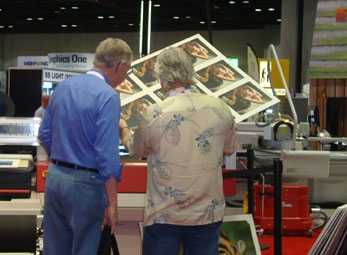We too often tend to “hear what we want to hear.” When looking to purchase a new flatbed printer, claims of high productivity are just one such example. Manufacturer’s specification sheets will often state very impressive top speeds, but how do you know that is a usable mode as it relates to real world production of saleable prints? You really need to dig deeper.
The highest print speed is often referred to as “draft” mode, which may be useful for producing simple line drawings but may not produce adequate enough quality for many graphics applications or image content. Few printers are able to provide enough ink density at these higher speeds to produce saleable quality areas of solid colors.
To evaluate print modes, prospective printer buyers should really ask to see a range of test prints of the same image produced across all print modes, i.e. Draft, Production, Quality, Fine Art. The criteria should be “what is the fastest speed where I can still sell this,” rather than focusing on slower modes where everything looks better but your overall throughput Is impacted.
Quoted print speeds are calculated using the entire print area. So if you are only printing an eight-foot-wide board on a ten-foot-wide printer, your optimization is only going to be 80% of the quoted speed. Additionally, some manufacturers will quote a particular speed but then demonstrate at trade shows (or produce benchmarks and samples) in unidirectional mode to maximize image quality. Uni-directional printing lays down the ink in only one direction of carriage travel. This cuts the quoted productivity in half! Always demand to see the prints produced in bi-directional mode.
There are other factors that impact the real productivity such as the time required to load the board, the time between hitting the print button and the first drop of ink being produced, and the time required to unload the board. This “print cycle” can also vary depending on the design of the printer. A true stationary flatbed with two-up, four-by-eight-foot capability such as the Océ Arizona XT models, allow loading of a second board while the first board is still printing. This means the printer never has to stop printing. The only overhead is in the loading for the first board. Other systems featuring hybrid or moving table designs require the print to be nearly or completely printed before the next board can be loaded.
As a result, the best test for how many boards-per-hour a printer will produce is to actually print and time with a stopwatch a successive number of boards.
Productivity is also not just limited to the printer. Consider what the labor component is to operate the printer. If the operator can hit “print” and walk away to perform other tasks, then this can benefit overall shop productivity allowing for more running time on the device and/or lower labor costs.
Finishing mistakes can also often result in wasted substrate, and the need for reprinting, which then reduces net productivity and increases cost. If the printer can print onto irregular shaped, pre-cut substrates—easily accomplished with a stationary flatbed—then finished “blanks” which could be cut in advance and used instead. This allows for greater flexibility and cost savings in the workflow.
So, before you sign an order for what you think is a good deal, make sure you’ve done your homework. Go see, in person, your prints being produced in the various print modes. Insist they be printed bi-directionally. Successively print multiple boards timed with a stopwatch. Only then can you get an apples-to-apples comparison on real productivity.
By Randy Paar, Canon Solutions America











